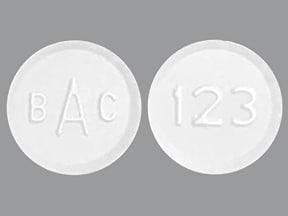Fioricet is intended as a treatment for tension headache.
It consists of a fixed combination of butalbital, acetaminophen, and caffeine. The role each component plays in the relief of the complex of symptoms known as tension headache is incompletely understood.

Fioricet is a combination medication that includes butalbital, acetaminophen, and caffeine. Each component has a distinct pharmacological profile, contributing to the overall therapeutic effect in treating tension headaches.

Components and Their Mechanisms of Action
- Butalbital
- Class: Barbiturate
- Mechanism: Butalbital enhances the activity of gamma-aminobutyric acid (GABA), an inhibitory neurotransmitter in the central nervous system (CNS). This action results in CNS depression, leading to sedative and muscle-relaxant effects, which can help alleviate the muscle tension often associated with tension headaches.
- Pharmacokinetics:
- Absorption: Well absorbed from the gastrointestinal tract.
- Distribution: Widely distributed throughout the body and crosses the blood-brain barrier.
- Metabolism: Metabolized primarily in the liver.
- Elimination: Excreted mainly in the urine as metabolites; the half-life ranges from 35 to 88 hours.
- Acetaminophen
- Class: Analgesic and antipyretic
- Mechanism: Acetaminophen works by inhibiting the synthesis of prostaglandins in the CNS and peripherally blocking pain impulse generation. It also acts on the hypothalamic heat-regulating center to produce antipyresis.
- Pharmacokinetics:
- Absorption: Rapid and almost complete absorption from the gastrointestinal tract.
- Distribution: Widely distributed throughout most body tissues, crosses the placenta, and is present in breast milk.
- Metabolism: Metabolized primarily in the liver via conjugation to glucuronide and sulfate.
- Elimination: Excreted in urine mainly as metabolites; the half-life is about 2 to 3 hours in adults.
- Caffeine
- Class: CNS stimulant
- Mechanism: Caffeine is a methylxanthine that acts as a central nervous system stimulant. It antagonizes adenosine receptors, resulting in increased neuronal firing and the release of neurotransmitters like dopamine and norepinephrine. This action can enhance alertness and counteract the sedative effects of butalbital.
- Pharmacokinetics:
- Absorption: Rapidly and completely absorbed from the gastrointestinal tract.
- Distribution: Distributed throughout all body tissues, including the CNS.
- Metabolism: Metabolized in the liver primarily via demethylation.
- Elimination: Excreted in the urine, mainly as metabolites; the half-life ranges from 3 to 7 hours in adults.
Therapeutic Uses
Fioricet is primarily indicated for the relief of complex tension (or muscle contraction) headaches. The combination of a sedative (butalbital), a pain reliever (acetaminophen), and a stimulant (caffeine) addresses different aspects of headache pain and tension.
Clinical Considerations
- Efficacy:
- Safety:
- Butalbital: Risk of dependency and tolerance with prolonged use.
- Acetaminophen: Risk of hepatotoxicity, especially at high doses or with chronic use.
- Caffeine: Potential for exacerbating anxiety, insomnia, or gastrointestinal discomfort.
- Contraindications:
- Hypersensitivity to any component.
- Severe hepatic impairment due to the acetaminophen component.
- Porphyria because of the butalbital component.
- Drug Interactions:
- CNS Depressants: Enhanced sedative effects when combined with other CNS depressants (e.g., alcohol, benzodiazepines).
- Hepatic Enzyme Inducers/Inhibitors: Drugs that affect liver enzymes can alter the metabolism of butalbital and acetaminophen.
- Anticoagulants: Acetaminophen can affect the anticoagulant properties of warfarin and other similar drugs.
- Adverse Effects:
- Common: Drowsiness, dizziness, nausea, and abdominal pain.
- Serious: Hepatotoxicity (from acetaminophen), respiratory depression (from butalbital), and dependence or withdrawal symptoms (from butalbital).
Summary
Fioricet combines the effects of butalbital, acetaminophen, and caffeine to effectively manage tension headaches through a synergistic approach. However, its use requires careful consideration of its pharmacological effects, potential for abuse, and risk of significant side effects. Proper patient selection and adherence to prescribed dosages are essential to maximize therapeutic benefits while minimizing risks.
Pharmacokinetics
The behavior of the individual components is described below.
Butalbital
Butalbital is well absorbed from the gastrointestinal tract and is expected to distribute to most tissues in the body. Barbiturates in general may appear in breast milk and readily cross the placental barrier. They are bound to plasma and tissue proteins to a varying degree and binding increases directly as a function of lipid solubility.
Elimination of butalbital is primarily via the kidney (59% to 88% of the dose) as unchanged drug or metabolites. The plasma half-life is about 35 hours. Urinary excretion products include parent drug (about 3.6% of the dose), 5-isobutyl-5-(2, 3-dihydroxypropyl) barbituric acid (about 24% of the dose), 5-allyl-5(3-hydroxy-2-methyl-1-propyl) barbituric acid (about 4.8% of the dose), products with the barbituric acid ring hydrolyzed with excretion of urea (about 14% of the dose), as well as unidentified materials. Of the material excreted in the urine, 32% is conjugated.
The in vitro plasma protein binding of butalbital is 45% over the concentration range of 0.5-20 mcg/mL. This falls within the range of plasma protein binding (20%-45%) reported with other barbiturates such as phenobarbital, pentobarbital, and secobarbital sodium. The plasma-to-blood concentration ratio was almost unity, indicating that there is no preferential distribution of butalbital into either plasma or blood cells.
Acetaminophen is rapidly absorbed from the gastrointestinal tract and is distributed throughout most body tissues. The plasma half-life is 1.25 to 3 hours, but may be increased by liver damage and following overdosage. Elimination of acetaminophen is principally by liver metabolism (conjugation) and subsequent renal excretion of metabolites. Approximately 85% of an oral dose appears in the urine within 24 hours of administration, most as the glucuronide conjugate, with small amounts of other conjugates and unchanged drug.
Like most xanthines, caffeine is rapidly absorbed and distributed in all body tissues and fluids, including the CNS, fetal tissues, and breast milk.
Caffeine is cleared through metabolism and excretion in the urine. The plasma half-life is about 3 hours. Hepatic biotransformation prior to excretion results in about equal amounts of 1-methylxanthine and 1-methyluric acid. Of the 70% of the dose that is recovered in the urine, only 3% is unchanged drug.
